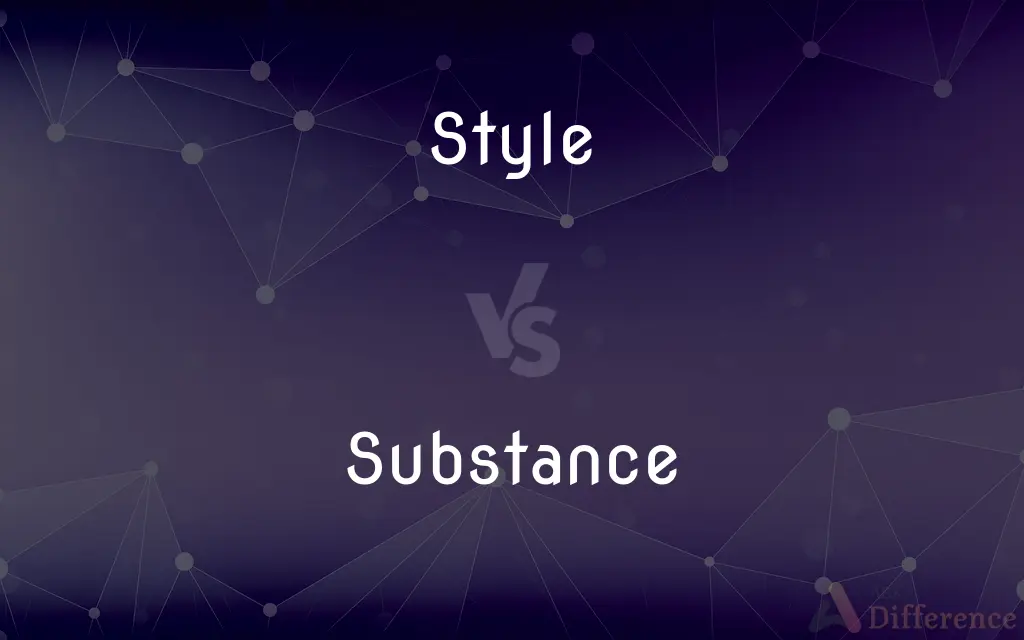Style vs. Substance — What's the Difference?
By Tayyaba Rehman & Fiza Rafique — Updated on March 26, 2024
Style refers to the manner of expression or presentation, often focusing on aesthetics or technique, while substance denotes the core content, meaning, or significance of something, emphasizing depth and value.

Difference Between Style and Substance
Table of Contents
ADVERTISEMENT
Key Differences
Style encompasses the distinctive ways in which ideas are expressed or presented, including writing, art, fashion, or architecture. It's about the aesthetic choices and techniques that create a particular look, feel, or impact. For instance, in writing, style could refer to an author's use of language, their sentence structure, or rhetorical devices that make their work recognizable or appealing. In contrast, substance deals with the actual content or material of the work, its themes, arguments, factual accuracy, and the depth of the ideas being presented. Substance is what gives a piece its weight and value, providing the audience with something meaningful or insightful.
While style can attract initial attention and engage an audience, it is the substance that sustains interest and prompts deeper reflection or learning. A work of art may be visually stunning (style), but if it lacks a meaningful message or emotional depth (substance), it may be seen as superficial. Conversely, content rich in substance may be overlooked if its presentation lacks the style needed to capture and retain the audience's interest.
The relationship between style and substance is not mutually exclusive but complementary. Effective communication often requires a balance between the two, where the style enhances the presentation without overshadowing the substance. For example, a well-designed educational lecture that uses engaging visuals (style) to clearly explain complex concepts (substance) can be more effective than one that focuses solely on one aspect.
In debates about the importance of style versus substance, opinions vary depending on the context and the values of the audience or critics. In some artistic or cultural fields, style might be prioritized as a form of expression or innovation. In academic, scientific, or practical domains, substance is often paramount, as the value lies in the information or functionality rather than the presentation.
The evaluation of style and substance is subjective and influenced by individual preferences, the purpose of the work, and the context in which it is consumed. While some may favor the elegance and technique of style, others may prioritize the depth and richness of substance, with the most enduring works often those that excel in both areas.
ADVERTISEMENT
Comparison Chart
Definition
The manner of expression or presentation.
The core content, meaning, or significance.
Focus
Aesthetics, techniques, and visual or sensory appeal.
Depth, value, and factual or conceptual content.
Importance
Engages and attracts the audience.
Provides meaning and sustains interest.
Relationship
Can enhance substance when well-executed.
Can be overshadowed if style is prioritized without depth.
Evaluation
Subjective, varies by cultural and individual preferences.
Generally prioritized in academic and practical contexts.
Compare with Definitions
Style
Fashion sense.
He's known for his impeccable style in both casual and formal wear.
Substance
Meaningful dialogue in films.
The film was praised for its substance, offering a critical look at societal norms.
Style
Presentation method.
The chef's unique style of presentation makes every dish a work of art.
Substance
Core content of a book.
The substance of her thesis was groundbreaking in the field of neuroscience.
Style
Architectural design.
The building's Gothic style stands out in the modern cityscape.
Substance
Factual accuracy in journalism.
The article's substance was verified by multiple sources.
Style
Personal expression in art.
His painting style is easily recognizable for its vibrant colors.
Substance
Depth in music lyrics.
His songs have substance, touching on themes of social justice and personal struggle.
Style
Writing technique.
Her writing style is concise and witty, making complex topics accessible.
Substance
Practical functionality in design.
The device's design prioritizes substance over style, focusing on usability.
Style
A particular procedure by which something is done; a manner or way
Different styles of management
Substance
That which has mass and occupies space; matter.
Style
A distinctive appearance, typically determined by the principles according to which something is designed
The pillars are no exception to the general style
Substance
A material of a particular kind or constitution.
Style
Fashionable elegance and sophistication
The world-famous hotel attracts guests because of its style and taste
Substance
A drug, chemical, or other material (such as glue) that one is dependent on or uses habitually and that is often illegal or subject to government regulation
Which substance was he abusing?.
Style
(in a flower) a narrow, typically elongated extension of the ovary, bearing the stigma.
Substance
The most important part or idea of what is said or written; the essence or gist
The substance of the report.
Style
(in an invertebrate) a small, slender pointed appendage; a stylet.
Substance
That which is real or practical in quality or character; practical value
A plan without substance.
Style
Archaic term for stylus (sense 2)
Substance
Significance or importance
Did he accomplish anything of substance?.
Style
Design or make in a particular form
The yacht is well proportioned and conservatively styled
Substance
Density; body
Air has little substance.
Style
Designate with a particular name, description, or title
The official is styled principal and vice chancellor of the university
Substance
Material possessions; goods; wealth
A person of substance.
Style
The way in which something is said, done, expressed, or performed
A style of teaching.
Substance
Physical matter; material.
Style
The combination of distinctive features of literary or artistic expression, execution, or performance characterizing a particular person, group, school, or era.
Substance
A form of matter that has constant chemical composition and characteristic properties.
Style
Sort; type
A style of furniture.
Substance
The essential part of anything; the most vital part.
Style
A quality of imagination and individuality expressed in one's actions and tastes
Does things with style.
Substance
Substantiality; solidity; firmness.
Some textile fabrics have little substance.
Style
A comfortable and elegant mode of existence
Living in style.
Substance
Material possessions; estate; property; resources.
A man of substance
Style
A mode of living
The style of the very rich.
Substance
Drugs illegal narcotics
Substance abuse
Style
The fashion of the moment, especially of dress; vogue
Clothes that are in style.
Substance
(theology) Hypostasis.
Style
A particular fashion
The style of the 1920s.
Substance
To give substance to; to make real or substantial.
Style
A customary manner of presenting printed material, including usage, punctuation, spelling, typography, and arrangement
A manual of style.
Substance
That which underlies all outward manifestations; substratum; the permanent subject or cause of phenomena, whether material or spiritual; that in which properties inhere; that which is real, in distinction from that which is apparent; the abiding part of any existence, in distinction from any accident; that which constitutes anything what it is; real or existing essence.
These cooks, how they stamp, and strain, and grind,And turn substance into accident!
Heroic virtue did his actions guide,And he the substance, not the appearance, chose.
Style
A name or title
Businesses under the style of Wilson and Webber.
Substance
The most important element in any existence; the characteristic and essential components of anything; the main part; essential import; purport.
This edition is the same in substance with the Latin.
It is insolent in words, in manner; but in substance it is not only insulting, but alarming.
Style
An implement used for etching or engraving.
Substance
Body; matter; material of which a thing is made; hence, substantiality; solidity; firmness; as, the substance of which a garment is made; some textile fabrics have little substance.
Style
A slender pointed writing instrument used by the ancients on wax tablets.
Substance
Material possessions; estate; property; resources.
And there wasted his substance with riotous living.
Thy substance, valued at the highest rate,Can not amount unto a hundred marks.
We are destroying many thousand lives, and exhausting our substance, but not for our own interest.
Style
The needle of a phonograph.
Substance
Same as Hypostasis, 2.
Style
The gnomon of a sundial.
Substance
To furnish or endow with substance; to supply property to; to make rich.
Style
(Botany) The usually slender part of a pistil, connecting the ovary and the stigma.
Substance
That which has mass and occupies space;
An atom is the smallest indivisible unit of matter
Style
(Zoology) A slender, tubular, or bristlelike process
A cartilaginous style.
Substance
The stuff of which an object consists
Style
(Medicine) A surgical probing instrument; a stylet.
Substance
The choicest or most essential or most vital part of some idea or experience;
The gist of the prosecutor's argument
The heart and soul of the Republican Party
The nub of the story
Style
(Obsolete) A pen.
Substance
The idea that is intended;
What is the meaning of this proverb?
Style
To design or fashion in a certain way
Styled the new model after the classic sports cars.
Substance
Considerable capital (wealth or income);
He is a man of means
Style
To arrange (hair) in a certain way, as by cutting, coloring, or curling.
Substance
What a communication that is about something is about
Style
To call or name; designate
George VI styled his brother Duke of Windsor.
Style
To make consistent with rules of style
Style a manuscript.
Style
Senses relating to a thin, pointed object.
Style
(historical) A sharp stick used for writing on clay tablets or other surfaces; a stylus; an instrument used to write with ink; a pen.
Style
A tool with a sharp point used in engraving; a burin, a graver, a stylet, a stylus.
Style
The gnomon or pin of a sundial, the shadow of which indicates the hour.
Style
(botany) The stalk that connects the stigma(s) to the ovary in a pistil of a flower.
Style
(surgery) A kind of surgical instrument with a blunt point, used for exploration.
Style
(zoology) A small, thin, pointed body part.
Style
(by extension from sense 1.1) A particular manner of expression in writing or speech, especially one regarded as good.
Style
A legal or traditional term or formula of words used to address or refer to a person, especially a monarch or a person holding a post or having a title.
Monarchs are often addressed with the style of Majesty.
Style
A particular manner of creating, doing, or presenting something, especially a work of architecture or art.
Style
A particular manner of acting or behaving; (specifically) one regarded as fashionable or skilful; flair, grace.
As a dancer, he has a lot of style.
Backstabbing people is not my style.
Style
A particular way in which one grooms, adorns, dresses, or carries oneself; (specifically) a way thought to be attractive or fashionable.
Style
(computing) A visual or other modification to text or other elements of a document, such as boldface or italics.
Applying styles to text in a wordprocessor
Cascading Style Sheets
Style
A set of rules regarding the presentation of text (spelling, typography, the citation of references, etc.) and illustrations that is applied by a publisher to the works it produces.
The house style of the journal
Style
(transitive) To design, fashion, make, or arrange in a certain way or form (style)
Style
To call or give a name or title to.
Style
To create for, or give to, someone a style, fashion, or image, particularly one which is regarded as attractive, tasteful, or trendy.
Style
To act in a way which seeks to show that one possesses style.
Style
An instrument used by the ancients in writing on tablets covered with wax, having one of its ends sharp, and the other blunt, and somewhat expanded, for the purpose of making erasures by smoothing the wax.
Style
Hence, anything resembling the ancient style in shape or use.
Style
A pen; an author's pen.
Style
Mode of expressing thought in language, whether oral or written; especially, such use of language in the expression of thought as exhibits the spirit and faculty of an artist; choice or arrangement of words in discourse; rhetorical expression.
High style, as when that men to kinges write.
Style is the dress of thoughts.
Proper words in proper places make the true definition of style.
It is style alone by which posterity will judge of a great work.
Style
A sharp-pointed tool used in engraving; a graver.
Style
Mode of presentation, especially in music or any of the fine arts; a characteristic of peculiar mode of developing in idea or accomplishing a result.
The ornamental style also possesses its own peculiar merit.
Style
A kind of blunt-pointed surgical instrument.
Style
Conformity to a recognized standard; manner which is deemed elegant and appropriate, especially in social demeanor; fashion.
According to the usual style of dedications.
Style
A long, slender, bristlelike process, as the anal styles of insects.
Style
Mode or phrase by which anything is formally designated; the title; the official designation of any important body; mode of address; as, the style of Majesty.
One style to a gracious benefactor, another to a proud, insulting foe.
Style
The pin, or gnomon, of a dial, the shadow of which indicates the hour. See Gnomon.
Style
A mode of reckoning time, with regard to the Julian and Gregorian calendars.
Style
The elongated part of a pistil between the ovary and the stigma. See Illust. of Stamen, and of Pistil.
Style
To entitle; to term, name, or call; to denominate.
How well his worth and brave adventures styled.
Style
A particular kind (as to appearance);
This style of shoe is in demand
Style
How something is done or how it happens;
Her dignified manner
His rapid manner of talking
Their nomadic mode of existence
In the characteristic New York style
A lonely way of life
In an abrasive fashion
Style
A way of expressing something (in language or art or music etc.) that is characteristic of a particular person or group of people or period;
All the reporters were expected to adopt the style of the newspaper
Style
Distinctive and stylish elegance;
He wooed her with the confident dash of a cavalry officer
Style
The popular taste at a given time;
Leather is the latest vogue
He followed current trends
The 1920s had a style of their own
Style
(botany) the narrow elongated part of the pistil between the ovary and the stigma
Style
Editorial directions to be followed in spelling and punctuation and capitalization and typographical display
Style
A pointed tool for writing or drawing or engraving;
He drew the design on the stencil with a steel stylus
Style
A slender bristlelike or tubular process;
A cartilaginous style
Style
Designate by an identifying term;
They styled their nation `The Confederate States'
Style
Make consistent with a certain fashion or style;
Style my hair
Style the dress
Style
Make consistent with certain rules of style;
Style a manuscript
Common Curiosities
Is the balance between style and substance the same across all fields?
No, the ideal balance varies by field, purpose, and audience, with some contexts prioritizing style and others substance.
Why might someone prioritize style over substance?
For aesthetic appreciation, to make a statement, or because the context values presentation and innovation.
Can a work have style without substance?
Yes, but it may be seen as superficial or lacking depth, potentially diminishing its lasting impact or value.
How can style enhance substance?
By making the presentation more engaging and accessible, style can help to effectively communicate and emphasize the substance.
How do critics evaluate style and substance?
Critics consider both elements, often assessing how well the style communicates the substance and the depth and originality of the substance itself.
Is substance more important than style?
It depends on the context and the audience's values; however, substance is often seen as crucial for lasting significance.
Can focusing too much on style be detrimental?
Yes, if style overshadows substance, the work may fail to provide meaningful content or insight, reducing its overall impact.
How can educators teach the importance of substance?
By emphasizing critical thinking, depth of understanding, and the value of meaningful content beyond aesthetics.
How do trends affect style and substance?
Trends can influence the popularity of certain styles or thematic substances, though timeless works often transcend current trends.
Can one improve the substance of their work?
Yes, through research, reflection, and focusing on depth of content and insight, one can enhance the substance of their work.
Can technological advancements impact style and substance?
Yes, they can introduce new styles and presentation methods while also expanding the possibilities for substance through access to information and innovative concepts.
How do preferences for style versus substance reflect cultural differences?
Cultural backgrounds can influence whether style or substance is valued more, based on societal norms and aesthetic preferences.
What role does audience play in the balance of style and substance?
The audience's expectations and values can dictate the creator's focus on style or substance to engage and satisfy them.
Share Your Discovery

Previous Comparison
Bold vs. Brazen
Next Comparison
Branch vs. TwigAuthor Spotlight
Written by
Tayyaba RehmanTayyaba Rehman is a distinguished writer, currently serving as a primary contributor to askdifference.com. As a researcher in semantics and etymology, Tayyaba's passion for the complexity of languages and their distinctions has found a perfect home on the platform. Tayyaba delves into the intricacies of language, distinguishing between commonly confused words and phrases, thereby providing clarity for readers worldwide.
Co-written by
Fiza RafiqueFiza Rafique is a skilled content writer at AskDifference.com, where she meticulously refines and enhances written pieces. Drawing from her vast editorial expertise, Fiza ensures clarity, accuracy, and precision in every article. Passionate about language, she continually seeks to elevate the quality of content for readers worldwide.














































